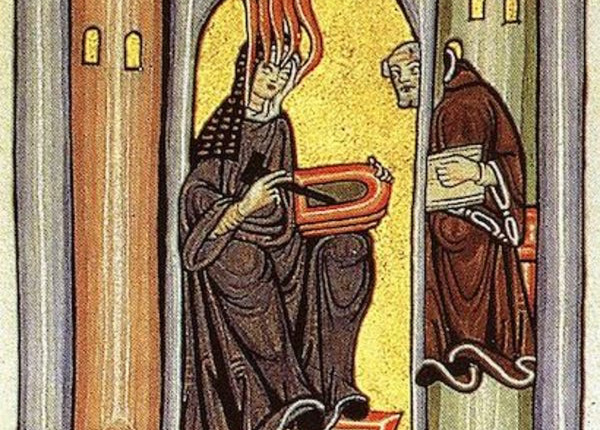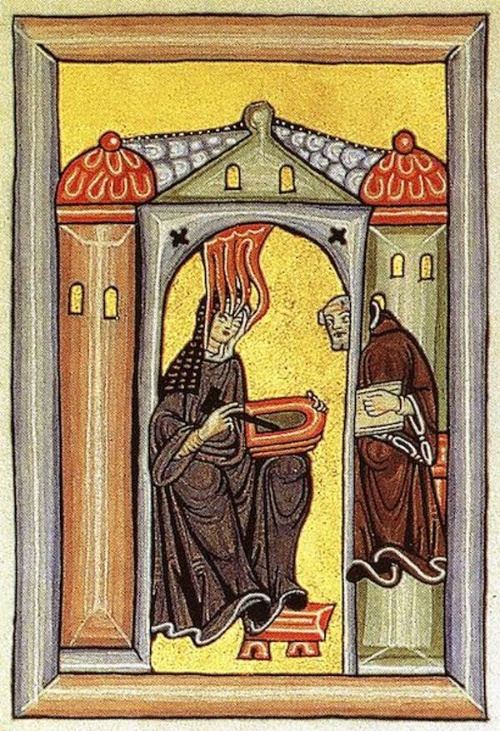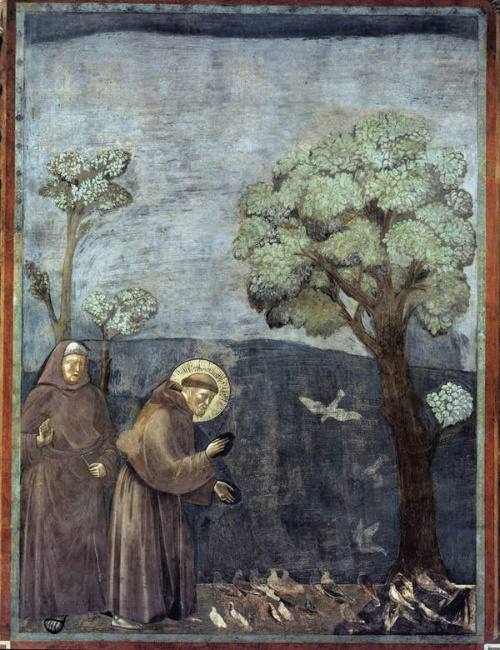
In an article first pubished on The Conversation, religious studies professor JOANNE M PIERCE, looks at the history of advocating for care of the Earth in the Catholic tradition…
Pope Francis led dozens of religious leaders on 4th October in issuing a plea to protect the environment, warning that “Future generations will never forgive us if we miss the opportunity to protect our common home.”
The appeal, which calls for net-zero emissions, was released after months of meetings leading up to the United Nations’ November climate conference in Glasgow, Scotland.

Hildegard of Bingen did it all: music, botany, medicine, drama and theology. PICTURE: Miniatur aus dem Rupertsberger Codex des Liber Scivias/Wikimedia Commons
“Early Christians insisted that the beauty of creation reflected God’s glory. But as Christianity spread throughout the Roman Empire, they had to defend this view of the basic goodness of creation when challenged by another religious viewpoint.”
The Pope has voiced support for green policies before, including his 2015 encyclical letter to the entire Catholic Church On Care for Our Common Home.
But Francis is not the first Catholic leader to emphasise care for the planet. In fact, every pope for the past half-century – except John Paul I, who died after just one month in office – has addressed environmental issues in their official publications.
As a scholar whose research focuses on the medieval church, I see many of these concerns deeply rooted in the history of the Catholic tradition.
The early tradition
One of the basic beliefs of Christianity is that the material world was created directly by God, and thus fundamentally connected with God’s goodness.
This is clearly expressed in the creation narrative in the book of Genesis, part of the sacred Scripture shared by Christians and Jews. As God completes each element of the world – day, night, land, sea, etc. – He sees that “it was good.” On the sixth day, when God creates human beings in God’s own image, they are given “dominion” or “rule” over everything that lives on the Earth.
Early Christians insisted that the beauty of creation reflected God’s glory. But as Christianity spread throughout the Roman Empire, they had to defend this view of the basic goodness of creation when challenged by another religious viewpoint.
This movement – called Gnosticism, from the Greek word meaning “knowledge” – taught that the physical world was created not directly by God, but by a lesser spiritual being, out of malice or ignorance. At best, the material world was a worthless distraction; at worst, an evil snare for human souls. Gnostic teachers offered to teach their followers how to free their spirits from attachment to their physical bodies and the material world. In this way, after death they could return to the realm of spiritual reality and reunite with the divine.
Many theologians and bishops criticised this interpretation of their faith. Several wrote lengthy, detailed critiques of Gnostic teaching; at stake, they believed, was the salvation of souls.
The most prominent of these was St Irenaeus of Lyons, who lived in the second century AD. On 7th October, 2021, Francis announced that he would declare Irenaeus a “Doctor of the Church,” a title reserved for saints whose writings have had a profound impact on the life of the Church.
In Irenaeus’ treatise Against the Heresies, a passionate defense of the teaching of the Scriptures and apostles, he states that creation itself reveals God and God’s glory; the only higher revelation is Jesus Christ himself.
At the beginning of the Middle Ages, however, Western Christianity was left with a lingering suspicion of “worldly things,” despite this early stress on the basic goodness of material creation.

St Francis, patron saint of animals and ecology, famously preached to the birds. PICTURE: Giotto di Bondone/Basilica of San Francesco d’Assisi/Wikimedia Commons
The Benedictine tradition
By the third century, some Christians began to seek a life more fully focused on God by removing themselves from society to pray and work together in communal groups. This kind of monasticism swept across Western Europe during the medieval period.
The most influential of these monastic orders were the Benedictines, who balanced their lives between daily prayer services and work – which often involved agriculture and care of the surrounding environment. Each monk or nun pledged to remain at the same monastery for life, unless its abbot or abbess – the monk or nun in charge – ordered them to move to another. Because of this, Benedictines became known as “lovers of place.”
Today, one Benedictine saint has become especially connected with environmental concerns: St. Hildegard of Bingen, who died in AD 1179. This German abbess was one of the most accomplished women of the Middle Ages. An expert on herbal medicines and botany, she also wrote religious plays, composed liturgical chants and hymns, and authored theological works and poems based on her mystical experiences. She insisted that God loved the Earth as a husband loves a wife, and espoused a kind of “green” theology, called viriditas, condemning the harm that human activity could do to nature.
Hildegard has been acclaimed as an unofficial patron saint of environmentalists. In 2012, Pope Benedict XVI declared her a “Doctor of the Church,” like Irenaeus.
The Franciscan tradition
St Francis of Assisi, son of an Italian cloth merchant, has over the centuries become renowned for his love of the natural world. After time as a soldier and prisoner of war, Francis underwent a spiritual conversion. Rejecting his father’s wealth, he chose to live a life of radical poverty and public preaching until his death in AD 1226. Early on, male members of his new mendicant movement, the Franciscians, took religious vows but traveled from town to town with no fixed residence, begging for food and lodging.
One of Francis’ few documents is a poem, the Canticle of the Sun, which lyrically expressed his belief in the kinship between human beings and the rest of the natural world. Even the Sun and the Moon are addressed as “brother” and “sister.” And as he lay dying, it is said that he asked to be laid on the bare Earth.
Legends about his preaching and miracles circulated widely, and some involved his concern for animals, treating them with the same dignity as human beings. One story holds that he preached to birds and convinced a vicious wolf to live in peace with nearby townspeople.
In 1979, Pope John Paul II named St Francis the patron saint of ecology because he “revered nature as a wonderful gift of God.” And in 2015, Pope Francis used the first words of the Canticle of the Sun, Laudatio si’, to open his encyclical on the environment and serve as its official title.
Although often overshadowed by the notion that the material world is only a passing distraction, reverence for a creation deeply loved by God has also been an important part of Catholic tradition. Contemporary teaching on the environment is only its most recent expression.![]()
Joanne M Pierce, Professor Emerita of Religious Studies, College of the Holy Cross. This article is republished from The Conversation under a Creative Commons license. Read the original article.





